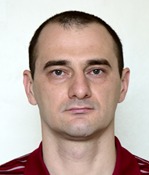Program Information
Effect of Magnetic Field On Stability of a Novel Dose Calculation Algorithm for MR-IGRT
O Zelyak1*, B Fallone1,2,3 , J St. Aubin1,2 , (1) University of Alberta, Edmonton, AB, (2) Cross Cancer Institute, Edmonton, AB, (3) MagnetTx Oncology Solutions, Edmonton, AB
Presentations
MO-F-FS1-2 (Monday, July 31, 2017) 4:30 PM - 6:00 PM Room: Four Seasons 1
Purpose: To investigate the iterative convergence rate of a deterministic solution to the linear Boltzmann transport equation (LBTE) with magnetic fields and potential acceleration methods.
Methods: The iterative convergence rate of the continuous and discretized LBTE including magnetic fields was determined by analyzing the spectral radius using Fourier analysis for the stationary source iteration (SI) scheme. The magnetic field can be included in the LBTE in two ways, 1) as a part of the iteration source, and 2) in the differential operator. The discretized LBTE was analyzed using the discontinuous finite element method (DFEM) in space and angle, where again Fourier analysis was used to determine the spectral radius. The non-stationary Krylov subspace solver GMRES was investigated as a potential method to accelerate the iterative convergence.
Results: It was found that SI was unstable when the magnetic field is part of the iteration source. When the magnetic field is included in the differential operator, SI was found to be unconditionally stable for any material and magnetic field. However, the spectral radius rapidly reached unity for very low density media and increasing magnetic field strengths. At the same time, GMRES was shown to significantly accelerate the convergence rate of the solution showing only a weak dependence on the magnetic field.
Conclusion: Source iteration of the DFEM space-angle LBTE with magnetic fields was found to be unconditionally stable, which contrasts with incorporating the magnetic field in the iteration source which was found to be unstable. The spectral radius of the DFEM LBTE was found to approach unity for low density media and strong magnetic fields. However, GMRES was found to largely overcome the convergence rate issues associated with SI.
Funding Support, Disclosures, and Conflict of Interest: Dr. Fallone is a co-founder and CEO of MagnetTx Oncology Solutions (under discussions to license Alberta bi-planar linac MR for commercialization). This project is partially supported by Alberta Innovates: Health Solutions organization.
Contact Email:
